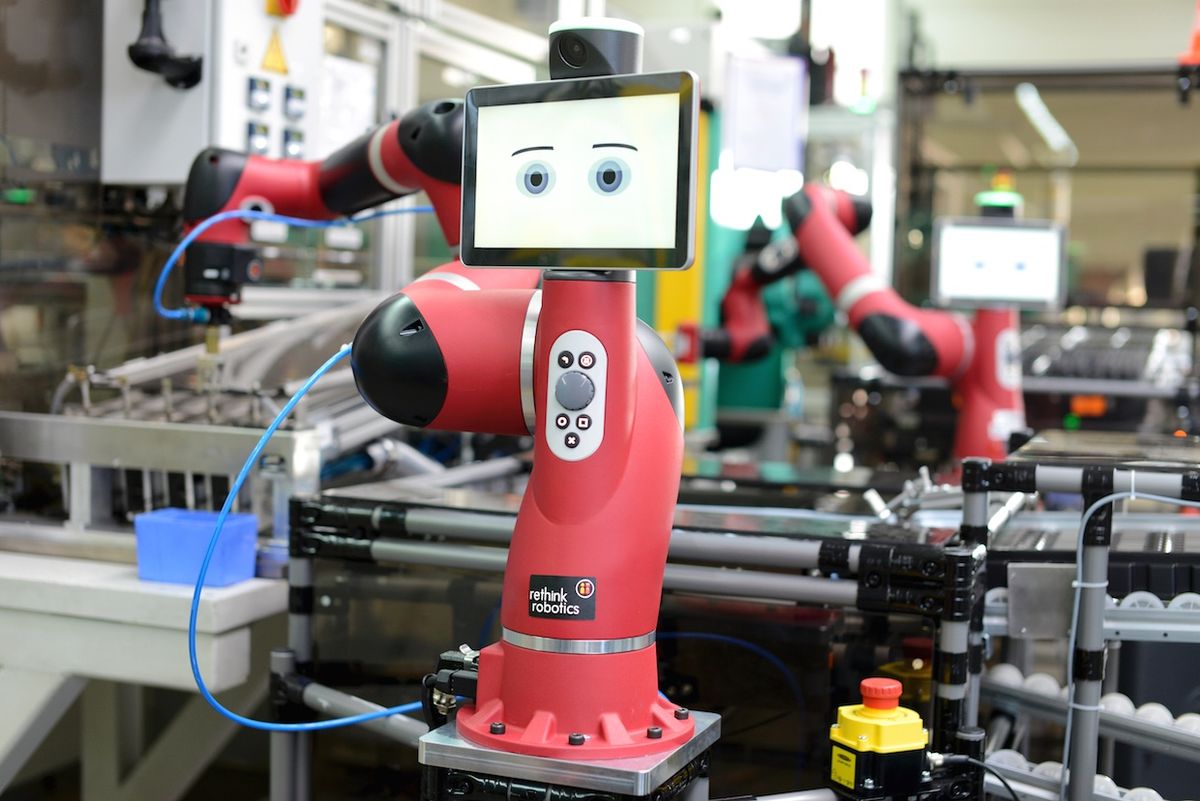Rethink Robotics is taking the wraps off a massive project that the company has been working on for two years. “It’s been a big part of our development that the world hasn’t seen,” says Rethink founder and CTO Rodney Brooks. “I’ve been so excited about this because I know what it can do.”
A little over a year ago, Rethink started shipping Sawyer, a collaborative robot designed to be faster, stronger, and more precise than the company’s first cobot, Baxter, which didn’t “sell like hotcakes,” as Brooks had expected. But developing a brand-new robot was just part of Rethink’s post-Baxter plans: Another goal was completely rebuilding its software platform, called Intera, which is responsible for controlling all of Sawyer’s functions as well as allowing users to program the robot.
Intera 5, which the company is announcing today, is “a big jump” from previous versions and will make Sawyer more versatile and easier to program, Brooks tells IEEE Spectrum. “It’s completely new,” he says, adding that 30 people worked on the software platform, which is based on ROS. “None of my code anymore. My code is gone.”
At the heart of the new system is what Brooks calls a “behavior engine” that lets users program complex tasks based on simpler ones. While in previous Intera releases large sequences of tasks were difficult to modify, now all tasks are graphically arranged as a behavior tree, making it easier to visualize, understand, and adjust what the robot is doing at every step.

The new software is critical for Rethink’s bid to gain more traction in the rapidly growing collaborative robots market. The Boston-based startup, which was founded in 2008 and has raised $131.5 million in VC funding, hasn’t disclosed sales numbers, but it says Sawyer is selling much better than Baxter, helping the company triple its revenue last year.
Other robot makers, including startups like Franka Emika, which plans to launch a cobot this year, are also devoting a lot of attention to their user interfaces and software features. Analysts credit an easy-to-use interface as a major factor in helping Danish firm Universal Robots dominate the cobot market, with thousands of robots shipped per year.
Rod Brooks says Rethink’s experience with Baxter showed that software is just as important as hardware when it comes to convincing manufacturers to embrace automation. With earlier versions of Intera, it was easy to get the robot to do most simple tasks, especially by using its teach-by-demonstration feature. But what Rethink found out is that many customers actually want to do much more complex tasks, and while Sawyer was in principle capable of carrying them out, programming the robot was the biggest hurdle.
“We were concentrating on teach by demonstration, and it was producing an internal representation which wasn’t visible to the user,” Brooks explains. “And the more sophisticated you were, the more frustrating the opaqueness of what was happening inside was.”

Intera 5’s behavior trees aim to solve this problem. The new interface provides an explicit visual diagram of the sequence of tasks the robot will run through. “Every node of a behavior tree, you can click down and get every possible parameter, every possible detail [of the robot],” Brooks says. “There’s nothing hidden.”
Brooks hopes the new system will help users master Sawyer’s advanced vision and force-sensing capabilities to tackle complex automation jobs, especially in the electronics manufacturing sector. To illustrate the point, Brooks likes to show off videos of Sawyer performing challenging tasks. In one, the robot uses its Cognex camera and force sensing to inspect switches, bolts, and wires on a water pump:
In another video, Sawyer is seen inserting a DIMM memory module on a motherboard. First, the robot positions the module on the socket by “feeling” its corners; it then gently pushes the DIMM down, measuring the force to detect whether it clicked or not. “We exposed a lot of the force control,” Brooks says. “So you can say, ‘Press down with 2 Newtons, but no more than 2 centimeters downwards, and be compliant in x and y, but rigid in rotation about the vertical z-axis’.”
Another challenge Rethink wants to solve with Intera 5 involves coordinating Sawyer and all the other assembly line components—conveyor belts, equipment to feed and sort parts, machines like drills and CNCs. Factories typically connect things using programmable logic controllers, or PLCs. “And PLCs suck,” Brooks says. “You can quote me on that.” A company would buy a Sawyer and put it to run right away, he says, but getting the PLCs and all the rest connected could take weeks and months. Now—in typical Internet of Things, or IoT, fashion—users will be able to plug a variety of assembly-line equipment directly to Sawyer and then control that with the same behavior tree that controls the robot on Intera.
Ultimately Brooks wants to focus on automating ever more complex tasks, disregarding the relatively simple applications that other cobot companies are currently pursuing, a market he believes will soon be taken over by cheaper robots from China. “I want to go somewhere different, that’s a much more interesting place to be, and which I think is the bigger market.”
At the same time he explains that making robots easier to use is much more than a business strategy for him. “It’s something that’s been with me since Day 1,” he says, noting that our consumer goods require no training and the same should apply to robots. “How many people need to be trained to use this?” he says, waving his iPhone. “It trains the person.”
Erico Guizzo is the director of digital innovation at IEEE Spectrum, and cofounder of the IEEE Robots Guide, an award-winning interactive site about robotics. He oversees the operation, integration, and new feature development for all digital properties and platforms, including the Spectrum website, newsletters, CMS, editorial workflow systems, and analytics and AI tools. An IEEE Member, he is an electrical engineer by training and has a master’s degree in science writing from MIT.



